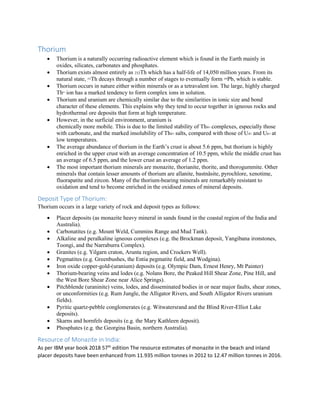Thorium.pdf
- 1. Thorium ï· Thorium is a naturally occurring radioactive element which is found in the Earth mainly in oxides, silicates, carbonates and phosphates. ï· Thorium exists almost entirely as 232Th which has a half-life of 14,050 million years. From its natural state, 232 Th decays through a number of stages to eventually form 208 Pb, which is stable. ï· Thorium occurs in nature either within minerals or as a tetravalent ion. The large, highly charged Th4+ ion has a marked tendency to form complex ions in solution. ï· Thorium and uranium are chemically similar due to the similarities in ionic size and bond character of these elements. This explains why they tend to occur together in igneous rocks and hydrothermal ore deposits that form at high temperature. ï· However, in the surficial environment, uranium is chemically more mobile. This is due to the limited stability of Th4+ complexes, especially those with carbonate, and the marked insolubility of Th4+ salts, compared with those of U4+ and U6+ at low temperatures. ï· The average abundance of thorium in the Earthâs crust is about 5.6 ppm, but thorium is highly enriched in the upper crust with an average concentration of 10.5 ppm, while the middle crust has an average of 6.5 ppm, and the lower crust an average of 1.2 ppm. ï· The most important thorium minerals are monazite, thorianite, thorite, and thorogummite. Other minerals that contain lesser amounts of thorium are allanite, bastnÃĪsite, pyrochlore, xenotime, fluorapatite and zircon. Many of the thorium-bearing minerals are remarkably resistant to oxidation and tend to become enriched in the oxidised zones of mineral deposits. Deposit Type of Thorium: Thorium occurs in a large variety of rock and deposit types as follows: ï· Placer deposits (as monazite heavy mineral in sands found in the coastal region of the India and Australia). ï· Carbonatites (e.g. Mount Weld, Cummins Range and Mud Tank). ï· Alkaline and peralkaline igneous complexes (e.g. the Brockman deposit, Yangibana ironstones, Toongi, and the Narraburra Complex). ï· Granites (e.g. Yilgarn craton, Arunta region, and Crockers Well). ï· Pegmatites (e.g. Greenbushes, the Entia pegmatite field, and Wodgina). ï· Iron oxide copper-gold-(uranium) deposits (e.g. Olympic Dam, Ernest Henry, Mt Painter) ï· Thorium-bearing veins and lodes (e.g. Nolans Bore, the Peaked Hill Shear Zone, Pine Hill, and the West Bore Shear Zone near Alice Springs). ï· Pitchblende (uraninite) veins, lodes, and disseminated bodies in or near major faults, shear zones, or unconformities (e.g. Rum Jungle, the Alligator Rivers, and South Alligator Rivers uranium fields). ï· Pyritic quartz-pebble conglomerates (e.g. Witwatersrand and the Blind River-Elliot Lake deposits). ï· Skarns and hornfels deposits (e.g. the Mary Kathleen deposit). ï· Phosphates (e.g. the Georgina Basin, northern Australia). Resource of Monazite in India: As per IBM year book 2018 57th edition The resource estimates of monazite in the beach and inland placer deposits have been enhanced from 11.935 million tonnes in 2012 to 12.47 million tonnes in 2016.
- 2. How from thorium uses as fuel: Thorium can be used as a nuclear fuel, through breeding to 233U. India is currently testing components for a 300 MWe (Megawatt electric) technology demonstrator thorium-fueled reactor and may commence construction some time during the period 2007 to 2012. Resources of Monazite State Resources (Mt) Andra Pradesh 3.69 Gujarat 0.003 Jharkhand 0.21 Kerala 1.84 Maharastra 0.004 Odisha 3.06 Tamilnadu 2.46 West Bengal 1.20 All India 12.47 Source: Department of Atomic Energy, Mumbai.
- 3. Thorium is therefore called fertile, whereas U-233 is called fissile. Reactors that use thorium are operating on whatâs called the Thorium-Uranium (Th-U) fuel cycle. Thorium (Th-232) is not itself fissile and so is not directly usable in a thermal neutron reactor. However, it is âfertileâ and upon absorbing a neutron will transmute to uranium-233, which is an excellent fissile fuel material. In this regard it is similar to uranium-238 (which transmutes to plutonium-239). All thorium fuel concepts therefore require that Th-232 is first irradiated in a reactor to provide the necessary neutron dosing to produce protactinium-233. The Pa-233 that is produced can either be chemically separated from the parent thorium fuel and the decay product U-233 then recycled into new fuel, or the U-233 may be usable âin-situâ in the same fuel form, especially in molten salt reactors (MRS). Thorium fuels therefore need a fissile material as a âdriverâ so that a chain can be maintained. The only fissile driver options are U-233, U-235 or Pu-239. (None of these is easy to supply).



